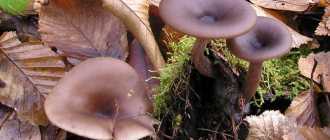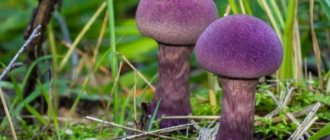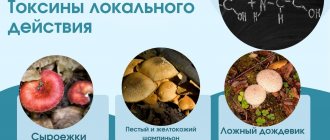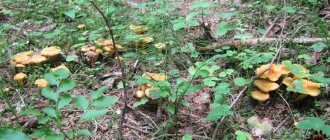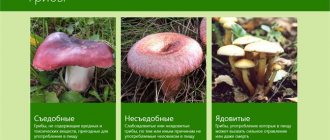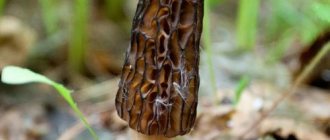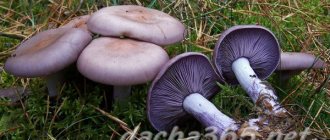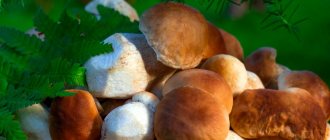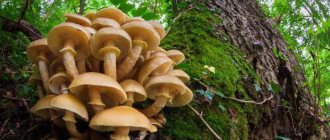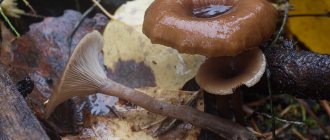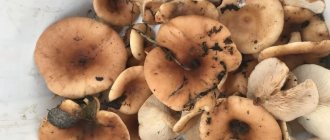Giant talker (Leucopaxillus giganteus) –
This mushroom is considered conditionally edible category 4. Pickling these mushrooms is popular. In addition, they are very tasty when eaten fresh. Ripe ones have a slightly bitter taste, so they are either dried or boiled before cooking. Young mushrooms can be dried; after boiling, they are eaten salted and boiled. This type of mushroom is included in the genus Leucopaxillus, being part of the family Tricholomataceae. She is part of a family of pigs, not talkers. But these two genera belong to the same family. Other names: giant white pig, giant white pig, huge leusopaxillus.
Where do giant talkers grow?
The species can be found in deciduous, coniferous and mixed forests. The mushroom prefers to grow in well-lit edges, clearings, roadsides, as well as in grazing areas and park areas.
In Russia it grows in the following regions:
- European part;
- Western Siberia;
- Far East;
- mountainous regions of the Caucasus.
The giant Crimean talker is also found. In the world, the mushroom can be found in Western Europe, North America and China.
Important! This fungus is a saprotroph, so it actively participates in the process of decomposition of forest litter and contributes to the formation of humus.
Recipes
Govorushki should be boiled before salting, drying or pickling. During the pickling process, a strong marinade with acetic acid and sterile containers are used. These mushrooms are best consumed together with fried and boiled vegetables. For pickling, take young mushrooms, which first need to be boiled for twenty minutes.
- Vinaigrette with talkers Boil beets, potatoes and carrots and cut into cubes. Then mix all these ingredients with pickled mushrooms, fresh onions and canned peas. Season with salt, lemon juice or sunflower oil.
- Marinade salad Marinated talkers are mixed with salted or pickled cucumbers, seasoned with salt, olive or sunflower oil. You can also add spices, pickled garlic and cold boiled potatoes.
What do giant talkers look like?
A distinctive feature of this species is its large size. The diameter of the cap in an adult specimen reaches 15-25 cm, but sometimes record holders up to 45 cm are found. The thickness of the upper part at the base in a transverse section is 1.5 cm.
The shape of the cap in young specimens is convex, less often flat, but as it grows it becomes concave, forming a funnel in the center. Along the edge it is lobed-wavy. The surface is initially finely velvety, but then the silkiness disappears, and circular scales and sometimes cracks appear.
The color of the cap and legs of the giant talker, as can be seen in the photo, is the same. Initially it is creamy-milky, and as the mushroom matures it becomes white-fawn with light ocher spots.
On the back side of the cap there are dense plates. They descend onto the leg and, with a little physical impact, are easily separated from it. They do not differ in shade from the main tone. The spores are translucent, oval or ellipse shaped. Their size is 6-8 x 3.5-5 microns. Spore powder is white.
The flesh of the mushroom is white, dense, elastic. When cut, it retains its shade. It has a faint smell of freshly ground flour.
The leg of the giant talker is characterized by a smooth surface, without a ring. Its height reaches 4.5-6 cm, and its cross-sectional diameter is 1.5-3 cm. The structure is fibrous and dry.
Preparation
Dishes with mushrooms are appropriate for both everyday and festive tables. White mountain has excellent taste and quite impressive size.
The taste and aroma of these mushrooms allows them to be used as a main or additional ingredient in a variety of cooking options. However, you should remember about mandatory heat treatment.
Cleaning
As you know, mushrooms are a fairly perishable product; they cannot last long. Cleaning is the first stage of preparation for further processing. First, the mushrooms should be thoroughly washed and dried. While the product is drying, you can prepare your cleaning tools.
You will need:
- Bowl;
- sharp knife;
- a small brush (an unnecessary toothbrush will do);
- towel.
Next you need to act in the following sequence:
- Cut off the lower part of the stem of the fruiting body, simultaneously clearing the contaminated layer with a knife.
- Use a towel to remove excess moisture.
- Next, the product is placed in salted water for fifteen minutes.
- Then the remaining dirt and the top layer, which does not contain useful substances, are removed with a brush.
- Rinse again under running water.
Each mushroom should be carefully examined for the presence of worms. If passages left by pests are found in the leg, it should be thrown away.
You should also cut off and discard all darkened areas. Only after this processing is the product ready for further preparation.
Important: if you plan to dry the mushrooms, you cannot wet them; you should use a regular paper napkin.
Cooking
Boil the mushrooms for 30–40 minutes. However, if they are then fried, then twenty minutes of heat treatment is sufficient. Peeled and chopped fruiting bodies are poured with cold salted water, which should completely cover them. Then the pan is put on fire.
The dried product is soaked for several hours, then boiled for twenty minutes. Frozen mushrooms take the same amount of time to cook; no preliminary defrosting is required.
You can cook it in a slow cooker, which almost every housewife has these days. To do this, select the “Baking” mode and cook for forty minutes. The same time will be needed for cooking in a double boiler.
Important: during the cooking process, any foam that forms should be removed.
Freezing
Frozen fruits and vegetables are often used to prepare various dishes during the winter season. Mushrooms are no exception. You can use them to prepare flavorful soups, pies and stews.
Freezing this product is very simple - just cut them after cleaning and place them in portions in a suitable container. Since food frozen and thawed several times loses its taste, it is recommended to choose a container of the appropriate size so that it can accommodate one required portion. It is important to remember that only thoroughly dried fruit bodies are frozen.
Frying
Fried porcini mushrooms have a unique aroma and are a great addition to any table. You can fry them pre-cooked or raw. If the product has been boiled, then it takes twenty minutes to cook.
In the case of raw mushrooms, you need to fry them for half an hour over low heat. You can add onions or sour cream to taste. At the end of cooking, the dish should be salted.
Pickling
Pickling is a favorite way of processing mushrooms. There are many types of pickling, with or without spices. For the simplest thing, you will need mushrooms and salt. For a bucket of whites you need to take two glasses of salt.
The cooking method is as follows:
- After thoroughly cleaning the main ingredient, it is necessary to separate the stems from the caps. The latter should be cut into several parts.
- Rinse under running water.
- Pour cold water over all the resulting pieces and put on fire.
- After boiling, place in a colander and cool.
- While the mushrooms are drying, you should prepare a container for pickling.
- The fruiting bodies are placed in a pan and sprinkled with a layer of salt about a couple of centimeters on top.
- Place a pressure that should completely cover the surface.
- The containers should remain in this state for five days at room temperature. During this time, the mushrooms will settle and their number will decrease.
- After five days, you can move the containers to a cooler place for long-term storage.
Another great pickling recipe - porcini mushrooms turn out crispy and aromatic.
You will need:
- main ingredient (1.5 kilograms);
- a small bunch of thyme;
- garlic (2 heads);
- dill umbrellas (2 sprigs);
- horseradish, currant and cherry leaves;
- salt (4 tablespoons).
The salting sequence is as follows:
- Cut processed and clean mushrooms into several pieces.
- Remove the husks from the garlic and separate it into cloves. Cut each tooth.
- Wash all greens under running water.
- Pour boiling water over a large capacity container prepared in advance and dry.
- Layer layers of horseradish leaves, mushrooms, salt, garlic, thyme and dill, cherry and currant leaves. Repeat the sequence until the main ingredient is gone.
- A heavy weight is placed on top.
- The container should be kept in a cool place for a week.
Benefits and harm to the body
Giant talker is distinguished by a high content of B vitamins, micro- and macroelements.
Other positive properties of this mushroom:
- reduces the level of bad cholesterol;
- removes toxins;
- normalizes the functioning of the digestive organs.
The antibacterial and anti-inflammatory effect of giant talker has found application in the treatment of tuberculosis. And the clitocybin contained in its composition allows you to treat diabetes mellitus and epilepsy.
During the process of growth and ripening, the fruiting body absorbs toxic substances and heavy metal salts like a sponge. Therefore, the older the mushroom, the higher the likelihood that it has accumulated harmful components.
Features of growing cephalaria
When planting cephalaria, it is worth considering that this plant is constantly growing and gaining power, becoming more beautiful and larger. Cephalaria are pleasantly surprising because they attract not only all possible honey-bearing insects and typical pollinators, but also different types of butterflies. Therefore, you need to choose a place for the plant where it can grow freely for decades and where there is no active movement that can scare away insects.
Cephalaria is a magnet for butterflies. matilde.l
Cephalaria are light-loving plants that prefer to grow in sunny areas, but they tolerate slight shading very well. The plant is absolutely undemanding to soil; it can develop and bloom in both poor and fertile soil, with almost any reaction and soil composition.
When choosing a place for cephalaria, it is worth remembering that in moist soils or with regular watering the plant grows at a gigantic pace and reaches enormous sizes. Therefore, when introduced into complex compositions, flower beds and mixborders, cephalaria is planted in combination with drought-resistant crops.
False doubles
According to the description, the giant talker is characterized by its large size, so it is very difficult to confuse adult specimens with other species. But it is worth learning to distinguish young mushrooms from their doubles, since many representatives of the Rowadovaceae family are similar to each other, but among them there are also poisonous ones.
Similar types:
- The talker is bent. A conditionally edible species that is superior in taste to other varieties of talkers. A distinctive feature is a tubercle in the center of the cap, which appears in young specimens and persists throughout the entire growth period. This species is also characterized by a white-ocher shade of the fruiting body and a taller stalk compared to its giant relative. The official name is Infundibulicybe geotropa.
- Funnel talker. A distinctive feature of this variety is the cap in the form of a deep funnel with a diameter of 10 cm with a thin and sinuous edge. The color of the fruiting body varies from brownish-fawn to yellow-ochre. You can also distinguish the funnel talker by its fruity smell. This mushroom is considered edible. In special reference books it can be found under the name - Clitocybe gibba.
- The talker is waxy. It belongs to the category of poisonous mushrooms, as it contains a high concentration of muscarine, which causes deadly intoxication. The cap is smooth, 6-8 cm in diameter, the edges are curved upward. The color of the fruiting body is off-white. Among mycologists it is known as Clitocybe phyllophila.
- The club-footed talker. It belongs to the category of conditionally edible mushrooms, but it should not be consumed in combination with alcohol. This species can be distinguished from its giant relative by the leg, which thickens at the base and resembles a club. Also a characteristic feature are rare descending plates. When cut, the flesh is ash-gray with a distinct mushroom smell. The official name is Ampulloclitocybe clavipes.
Can it be confused with other mushrooms?
Since talker mushrooms have several varieties, some of which are weakly and even highly poisonous, it is very important to learn to distinguish them from each other, so as not to have to deal with the serious consequences of poisoning.
Here are a few characteristics that distinguish the most common varieties:
- club-footed talker can be easily distinguished from other types of mushrooms - their name shows the characteristic structure of the stem, which cannot be confused with anything else. Housewives should remember that this mushroom is healthier in nutritional quality than its giant relative, and those who are accustomed to using mushrooms as a snack - that it is absolutely incompatible with alcohol;
- talker translucent it is considered poisonous; its cap, pink or red ocher in color, and sticky to the touch, will help you distinguish it from the giant one;
- of all representatives of this species bent (red) talker recognized as the highest quality mushroom, it differs from its giant relative not only in the red tint of the cap (which is given to it by rusty spots), but also in its lumpy surface;
- deadly waxy talker (it is also called grayish or leaf-shaped). Completely white, it has a convex cap with a hump-like tubercle located in the center and the presence of not very noticeable watery concentric circles.
Related species
Snow talkers grow around May. They appear in forests with coniferous trees and in sunny meadows. You can see them in groups, and very rarely alone. The fungus is, in principle, quite rare and not widespread.
Low-smelling talker is a type of talker that is not suitable for food. Young fruiting bodies have more convex caps, and then, as they age, they open into a funnel. The color of the hat is brown or slightly beige. The legs can be either flattened or cylindrical. Their color is noticeably lighter than the cap. The pulp of the govorushka is slightly odorous, gray, and has a persistent powdery odor and taste. You can meet them in small groups. Appear in December or January. They grow in pine forests, but can also be in mixed ones.
Read also: Artichoke: beneficial properties, harm and contraindications, photos
Poisonous species
The most common poisonous types of talkers are:
- whitish (whitish);
- waxy (waxy, grayish, leaf-loving);
Whitish talker
The whitish talker (Clitocybe candicans) is found quite often not only in forests, but also in parks. Mushrooms grow in large groups on soil or leaf litter. The cap reaches a diameter of 6 cm, in young mushrooms it has a convex shape with tucked edges, then the shape becomes prostrate, and in old mushrooms it changes to flat or depressed with wavy edges. The color also changes from whitish-gray (in young mushrooms) to ocher (in old ones). The leg tapers towards the base. As the fungus grows, the plates also change color from white to yellowish.
The mushroom contains more toxic substances than the red fly agaric. Symptoms of poisoning:
- After 15-20 minutes - strong salivation, watery eyes and active sweating.
- After 2 hours - weakening of the heart rate; respiratory distress, diarrhea, vomiting.
Beneficial features
Talker mushrooms have a lot of useful properties. They are low in calories, which is important for those who watch their diet and want to keep their weight normal. They have a lot of fiber, minerals, macro- and microelements.
Irina Selyutina (Biologist):
In the pharmaceutical industry, talkers are so-called. “primary raw material”, which is used to obtain several types of antibiotics, including clitocybin. This drug is very important for suppressing the activity of the tuberculosis bacillus and treating epilepsy. The fruiting bodies of talkers also contain nebularin, an antimicrobial substance that in its action resembles the antibiotic clitocybin, but it is less active and does not cause side effects.
The aqueous extract has almost the same effect as the antibiotics we know (levomycin, biomycin, streptomycin) on wound microflora.
Eating them helps improve digestion and strengthen the immune system. They prevent the formation of inflammatory processes and are a natural antibiotic. Systematically adding them to food helps improve memory and increase concentration. Also, edible types of talkers, when used regularly, can remove cholesterol plaques from blood vessels.
